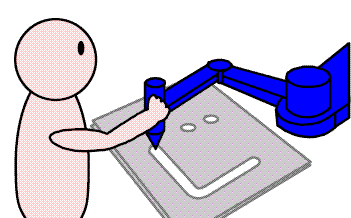How Slow Should a Robot Be?: Physics of Human-Robot Coordination |
[projects] [top] [Japanese] |
Imagine this kind of situation:
|

|
|
The question we faced was: in this kind of situation, what kind of controller should be used for the robot? Our suggestion is: use "PSMC" with the time constant 0.1 sec!! Why PSMC?: because the controller should be stiff enough but at the same time should be damped enough. With ordinary PD control, this means high P-gain and high D-gain are required. High D-gain is technically impossible due to the noise in the velocity measurements. How damped should it be?: From the experiments, we found the damping-to-stiffness ratio should be around 0.1 sec rather than 0.5 sec or 0.01 sec. Why 0.1 sec?: We have no idea, frankly. But this number has good agreement with previuos studies on human response during steering vehicles. See more details in section II.B of the paper below. The above situation may look too particular but I believe some classes of rehabilitation and human-machine coordination in manufacturing industry fall within this class of situation. I named it as a "low-force kinesthetic guidance." | |
-
Ryo Kikuuwe, Takahiro Yamamoto, and Hideo Fujimoto: “A Guideline for Low-Force Robotic Guidance for Enhancing Human Performance of Positioning and Trajectory Tracking: It Should Be Stiff and Appropriately Slow,” IEEE Transactions on Systems, Man, and Cybernetics, Part A: Systems and Humans, 38(4), pp. 945-957, July 2008.
- [pdf file] ©2008 IEEE. Personal use of this material is permitted. However, permission to reprint/republish this material for advertising or promotional purposes or for creating new collective works for resale or redistribution to servers or lists, or to reuse any copyrighted component of this work in other works must be obtained from the IEEE.
- The title exactly reflects our conclusion obtained through experiments. "Appropriately slow" here means specifically 0.1 sec in terms of time constant of decay, which means the ratio of D-gain to K-gain (i.e., viscosity to stiffness).
-
Ryo Kikuuwe, Takahiro Yamamoto, and Hideo Fujimoto: “Low-Force Kinesthetic Guidance For Accurate Positioning and Tracking,” In Proceedings of the 14th Symposium on Haptic Interfaces for Virtual Environment and Teleoperator Systems (Haptics 2006), pp. 491-498, March 2006 (Alexandria, USA).
- [pdf file] ©2006 IEEE. Personal use of this material is permitted. However, permission to reprint/republish this material for advertising or promotional purposes or for creating new collective works for resale or redistribution to servers or lists, or to reuse any copyrighted component of this work in other works must be obtained from the IEEE.
- [pdf of the poster at the conference site]
- Reading this conference paper first may confuse you because it is read as if the scheme of "low-force kinesthetic guidance" itself is proposed in this paper. But it is not what I intended. What I wanted to say is summarized in the poster version and is detailed in the above transaction paper.
Ryo Kikuuwe's Homepage